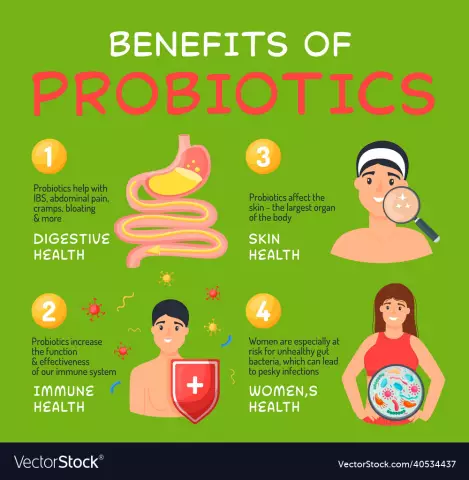- Author Rachel Wainwright [email protected].
- Public 2023-12-15 07:39.
- Last modified 2025-11-02 20:14.
Diane-35
Diane-35: instructions for use and reviews
- 1. Release form and composition
- 2. Pharmacological properties
- 3. Indications for use
- 4. Contraindications
- 5. Method of application and dosage
- 6. Side effects
- 7. Overdose
- 8. Special instructions
- 9. Use in childhood
- 10. For violations of liver function
- 11. Drug interactions
- 12. Analogs
- 13. Terms and conditions of storage
- 14. Terms of dispensing from pharmacies
- 15. Reviews
- 16. Price in pharmacies
Latin name: Diane-35
ATX code: G03HB01
Active ingredient: Cyproterone + Ethinylestradiol (Cyproterone + Ethinylestradiol)
Producer: Bayer Weimer GmbH & Co, KG (Germany)
Description and photo update: 2019-18-09
Prices in pharmacies: from 1045 rubles.
Buy

Diane-35 is a combined monophasic contraceptive with antiandrogenic properties.
Release form and composition
Dosage form - dragees (21 pcs. In blisters, in a cardboard box 1 blister).
Content of active ingredients in 1 tablet Diane-35:
- Cyproterone acetate - 2 mg;
- Ethinylestradiol - 0.035 mg.
Excipients: corn starch, lactose monohydrate, povidone, magnesium stearate, talc (magnesium hydrosilicate).
Shell composition: povidone 700,000, sucrose, macrogol 6000, titanium dioxide, calcium carbonate, mountain glycolic wax, glycerol, iron (II) oxide, talc (magnesium hydrosilicate).
Pharmacological properties
Pharmacodynamics
Diane-35 is a low-dose, monophasic oral estrogen-antiandrogenic combination contraceptive drug. It prevents conception by suppressing ovulation and altering the characteristics of the cervical secretion, which makes it impermeable to sperm.
In women taking Diane-35, the menstrual cycle normalizes, the soreness of menstruation and the intensity of bleeding decrease, which minimizes the risk of developing iron deficiency anemia. It has been suggested that the use of the drug is justified in order to prevent ovarian cancer and endometrial cancer.
Against the background of taking a contraceptive, the activity of the sebaceous glands decreases, which plays an important role in the occurrence of seborrhea and acne. The course of therapy lasting 3-4 months leads to almost complete disappearance of acne and excessive oiliness of the scalp. It also slows down hair loss, which is often a symptom of seborrhea. Taking Diane-35 by women of reproductive age weakens the clinical manifestations of mild hirsutism (for example, increased facial hair growth), but the result of treatment becomes noticeable only after a few months of therapy.
Cyproterone acetate, in addition to antiandrogenic, is also characterized by a pronounced gestagenic effect.
Pharmacokinetics of cyproterone acetate
When taken orally, cyproterone acetate is completely absorbed almost regardless of dose. After oral administration of Diane-35, the maximum serum level of the compound, which is 15 ng / ml, is reached after 1.6 hours. The absolute bioavailability of cyproterone acetate is approximately 88% of the dose.
This active component of the contraceptive binds only to serum albumin. In the free form, approximately 3.5-4% of cyproterone acetate in the blood serum remains. The increase in SHBG caused by ethinyl estradiol does not affect the binding of the compound to serum proteins. The average apparent volume of distribution is 986 ± 437 L.
Cyproterone acetate is metabolized by conjugation or hydroxylation. The main metabolite in human plasma is the 15β-hydroxyl derivative.
A certain part of the dose of Diane-35 is excreted unchanged in the bile. Most of the cyproterone acetate contained in it is excreted as metabolites in the urine or bile in a 1: 2 ratio. The half-life of eliminated metabolites from plasma is 1.8 days.
Since there is no specific binding to proteins, a change in the concentration of sex steroid binding globulin (SHBG) does not affect the pharmacokinetics of cyproterone acetate. During the menstrual cycle, the highest equilibrium concentration of this substance in the blood serum is observed in the second half of the cycle.
Pharmacokinetics of ethinyl estradiol
After oral administration, ethinyl estradiol is completely absorbed in a minimal period of time. Its maximum serum concentration of 71 pg / ml is reached in 1.6 hours. In the process of absorption and "first pass" through the liver, ethinyl estradiol forms metabolites, and its bioavailability averages about 45%.
The compound is almost completely (98%) bound to albumin, but not in a specific type. It promotes the synthesis of SHBGs. The apparent volume of distribution of ethinylestradiol is 2.8-8.6 l / kg.
Ethinylestradiol is subject to presystemic conjugation in the liver and in the mucous membrane of the small intestine. The main route of its metabolism is aromatic hydroxylation. The clearance rate from plasma is 2.3-7 ml / min / kg.
The decrease in the content of ethinyl estradiol in the blood serum occurs in two stages: in the first phase, the half-life is approximately 1 hour, in the second phase, 10-20 hours. The substance is not excreted from the body unchanged. Its metabolites are excreted in urine and bile in a ratio of 4: 6, with an elimination half-life of approximately 24 hours.
The equilibrium concentration of ethinyl estradiol is achieved during the second half of the course of treatment.
Indications for use
The use of the drug is indicated for women with symptoms of androgenization as oral contraception.
In addition, Diane-35 is prescribed for the treatment of androgen-dependent diseases in women: severe forms of acne, accompanied by seborrhea, the formation of inflammatory nodes, including nodular-cystic acne, papular-pustular acne; mild forms of hirsutism; androgenic alopecia.
Contraindications
- Thromboembolism and thrombosis, including a history of (cerebrovascular disorders, deep vein thrombosis, myocardial infarction, pulmonary embolism);
- The presence of multiple or severe signs of risk of arterial or venous thrombosis;
- Angina pectoris, transient ischemic attacks and other conditions preceding thrombosis;
- Liver tumors, including a history of
- Liver disease or severe functional disorders;
- Pancreatitis, including a history if it was accompanied by severe hypertriglyceridemia;
- Diabetes mellitus complicated by microangiopathies;
- A history of migraine, which proceeded with focal neurological symptoms;
- Uterine bleeding of unknown origin;
- Hormone-dependent malignant neoplasms, including tumors of the genitals or breast (including a history);
- Hypersensitivity to drug components.
The drug must be immediately canceled if any of these pathologies develops for the first time against the background of the use of Diane-35.
The drug is also contraindicated in cases of suspected pregnancy, during gestation and breastfeeding.
Instructions for use Diane-35: method and dosage
Dragee is taken orally, without chewing, with a small amount of liquid, preferably immediately after breakfast or dinner.
Dosage of the drug - 1 tablet per day.
Reception begins on the first day of the cycle, using pills of the corresponding day of the week from the calendar package, at a time convenient for the patient, with the condition that subsequent receptions will necessarily be carried out at this specific hour of the day.
For each next reception, use the pills from the cell, which is indicated by the arrow applied to the foil from the previous one. Following the direction on the calendar package, the woman takes all 21 pills and takes a break of 7 days, during which bleeding similar to menstruation passes. One course of therapy lasts 28 days, of which 21 days - taking pills and 7 days - a break. It must be remembered that the reception should not be interrupted for more than 7 days and the first 7 days of taking the pills are required to achieve the appropriate suppression of the function of the hypothalamic-pituitary-ovarian system.
The day of taking the drug from the next package must coincide with the day of the week on the calendar package of the previous course and begin on the 8th day after the start of the break at the strictly established time.
To switch from combined oral contraceptives to the use of Diane-35, the reception must be started the next day after the last tablet from the package with the active substances of the previous drug, for a calendar package for 28 tablets and no later than 1 day after a 7-day break, for contraceptives from 21 dragee.
To switch from drugs consisting only of gestagens ("mini-pills"), Diane-35 can be taken without interruption, with injectable forms of contraception - from the day of the next injection, with an implant - on the day of its removal. At each of these transitions, it is additionally necessary to use a barrier method of contraception during the first 7 days.
When an abortion is performed in the 1st trimester of pregnancy, oral contraception is started immediately, in which case additional methods of contraception are not required.
In the absence of sexual intercourse after an abortion in the II trimester of pregnancy or childbirth, it is recommended to start using the drug on the 21-28th day. If a woman started taking it later, then during the first 7 days, a barrier method of contraception should be used in parallel. Patients who have had sexual intercourse in the interval between abortion or childbirth and the beginning of the use of the drug should wait for the first menstruation or exclude pregnancy.
If a woman missed taking pills at the set time, it must be taken as soon as possible, and the next pills - at the usual time. The reliability of contraception is not impaired if you are late less than 12 hours.
In the case when more than 36 hours have passed since the last dose (more than 12 hours late), the missed pills should be taken immediately, as soon as they remembered, even if it will be taking two pills at the same time, while the next dose is taken at the usual time. If the violation occurred in the first or second week of use, it is necessary to use a barrier method of contraception for the next 7 days. If you are more than 12 hours late during the third week of admission, after the end of the calendar packing, you do not need to take a break in admission, you must continue taking from the next blister. During reception from the second package, a woman may experience bloody spotting or breakthrough uterine bleeding.
If the patient has vomiting after taking the pills (in the first 3-4 hours), the absorption of active substances may be impaired and incomplete, therefore, you should use the recommendations for the case when you miss a dose.
To delay the onset of menstruation, you must continue taking pills from a new calendar package, without taking a 7-day break. You can take pills from the second package until its end. You should know that during this period the patient may experience spotting or breakthrough bleeding. After a 7-day break, you should continue using Diana-35 from a new package.
To change the day of the beginning of the menstrual cycle to another, the next break should be shortened by the required number of days. The fewer the days of the break, the more likely there is no withdrawal bleeding and the presence of spotting bleeding during the period of taking the pills.
The duration of taking the drug in the treatment of hyperandrogenic pathologies depends on the severity of the condition, after the disappearance of the signs of the disease, it is recommended to continue taking the pills for 3-4 months. If a relapse occurs, you can repeat the course of therapy.
Side effects
The use of the drug can cause side effects:
- From the reproductive system: rarely - intermenstrual bleeding, changes in libido, disorders of vaginal secretions;
- From the digestive system: rarely - nausea and vomiting;
- From the side of the nervous system: rarely - migraine, decreased mood, headache;
- From the endocrine system: rarely - change in body weight, engorgement, enlargement, tenderness of the mammary glands and discharge from them;
- Others: very rarely - allergic reactions, poor tolerance of contact lenses, the appearance of age spots on the face (chloasma).
These side effects can appear in the first months of taking the drug and, as a rule, gradually decrease.
Overdose
Symptoms of an overdose with Diane-35 are slight vaginal bleeding (in girls), nausea, vomiting. There is no specific antidote. If necessary, symptomatic therapy is prescribed.
special instructions
The use of Diane-35 can only be started after a general medical examination, including a cytological examination of cervical mucus, mammary glands, to exclude violations of the blood coagulation system and the presence of pregnancy. Control examinations with prolonged use of the drug are recommended to be carried out once every six months.
If there are risk factors, a woman should make a decision about the forthcoming therapy, carefully assessing the potential risk and expected benefit from taking the drug.
A woman should be informed about the possible development of arterial or venous thrombosis, and the need to immediately consult a doctor if the first symptoms appear. These include: movement disorders; swelling and / or one-sided leg pain; sharp pain in the chest with or without radiation to the left arm; unexpected shortness of breath and / or a coughing fit; severe and prolonged headache; increased severity and frequency of migraines; sudden loss of vision (partial or complete); diplopia; dizziness; slurred speech or aphasia; other.
If persistent arterial hypertension develops, the drug should be discontinued, after appropriate antihypertensive therapy and blood pressure normalization, the contraceptive can be continued.
The occurrence of functional disorders of the liver may require a temporary cancellation of the Diane-35 intake until the laboratory parameters are normalized. With recurrent cholestatic jaundice, combined oral contraceptives should be discontinued.
Patients with diabetes mellitus do not need to adjust the dose of hypoglycemic drugs, but women in this category should be under special medical supervision.
Chloasma-prone patients are advised to avoid exposure to ultraviolet radiation and prolonged exposure to the sun.
Evaluation of irregular bleeding (spotting or breakthrough bleeding) that occurs during the use of Diane-35 in the first months of therapy should be carried out after an adaptation period that lasts three cycles.
The development of irregular bleeding after previous systematic cycles should involve consideration of non-hormonal causes, diagnostic measures to exclude pregnancy or malignant neoplasms, including curettage.
When carrying out a differential diagnosis in women with hirsutism, an androgen-producing tumor, congenital dysfunction of the adrenal cortex should be attributed to the reasons for the appearance or significant increase in the symptoms of the disease.
If there is no withdrawal bleeding during the 7-day break after taking two calendar packs of the drug in a row, it is recommended to exclude pregnancy before continuing.
Influence on the ability to drive vehicles and complex mechanisms
According to available data, Diane-35 does not significantly affect the ability to drive vehicles or mechanisms with a complex operating principle.
Childhood use
According to the instructions, Diane-35 is prescribed to adolescents only after the onset of menarche.
For violations of liver function
If liver dysfunctions occur, it is advisable to temporarily discontinue the drug until laboratory parameters improve. Recurrent cholestatic jaundice, first diagnosed during pregnancy or a previous course of sex hormone therapy, is an indication to stop taking Diane-35.
Drug interactions
The contraceptive reliability of Diane-35 decreases when taken simultaneously with tetracyclines and ampicillins.
When combined with inducers of microsomal hepatic enzymes, including barbiturates, hydantoins, primidone, rifampicin, carbamazepine, and possibly with topiramate, oxcarbazepine, felbamate and griseofulvin, an increase in the clearance of active substances occurs, this can cause breakthrough uterine bleeding and reduce the reliability of contraception.
Analogs
Analogs of Diana-35 are: Bellune-35, Erica-35, Chloe.
Terms and conditions of storage
Store at room temperature. Keep out of the reach of children.
The shelf life is 5 years.
Terms of dispensing from pharmacies
Dispensed by prescription.
Reviews about Diana-35
Numerous reviews about Diana-35 are of a different nature. Many women note the convenience of using the drug and a lasting positive effect. The drug successfully helps to cope with acne and significantly improve the condition of the skin.
The opinion of most gynecologists about the contraceptive is also favorable: they note a good contraceptive effect and the success of therapy when Diane-35 is prescribed according to indications. It is argued that in many cases, pregnancy after drug withdrawal occurred faster, especially if conception did not occur for a long time before. However, there are many complaints about serious side effects of Diane-35, expressed in a general decrease in tone, nausea, heart palpitations, weight gain, as well as the high cost of the drug.
Price for Diana-35 in pharmacies
On average, the price for Diane-35 varies in the range from 1000 to 1150 rubles per pack containing 21 pills.
Diane-35: prices in online pharmacies
|
Drug name Price Pharmacy |
|
Diane-35 2 mg + 0.035 mg dragee 21 pcs. 1045 RUB Buy |
|
Diane-35 dragee 21 pcs. 1076 RUB Buy |

Maria Kulkes Medical journalist About the author
Education: First Moscow State Medical University named after I. M. Sechenov, specialty "General Medicine".
Information about the drug is generalized, provided for informational purposes and does not replace the official instructions. Self-medication is hazardous to health!






